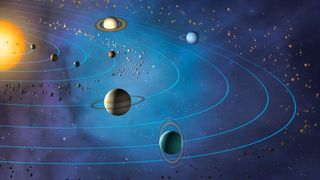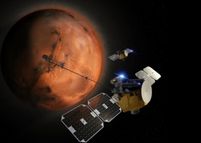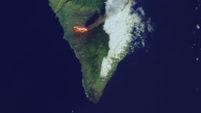Why do the planets in the solar system orbit on the same plane?
- Get link
- X
- Other Apps
To answer this question, we have to go back in time.

If you've ever gazed at a model of the solar system, you've likely noticed that the sun, planets, moons and asteroids sit roughly on the same plane. But why is that?
To answer this question, we have to travel to the very beginning of the solar system, about 4.5 billion years ago.
Back then, the solar system was just a massive, spinning cloud of dust and gas, Nader Haghighipour, an astronomer at the University of Hawaii at Mānoa, told Live Science. That massive cloud measured 12,000 astronomical units (AU) across; 1 AU is the average distance between Earth and the sun, or about 93 million miles (150 million kilometers). That cloud became so big, that even though it was just filled with dust and gas molecules, the cloud itself started to collapse and shrink under its own mass, Haghighipour said.
Related: Why are galaxies different shapes?
As the spinning cloud of dust and gas started to collapse, it also flattened. Imagine a pizza maker throwing a spinning slab of dough into the air. As it spins, the dough expands but becomes increasingly thin and flat. That's what happened to the very early solar system.
Meanwhile, in the center of this ever-flattening cloud, all those gas molecules got squeezed together so much, they heated up, Haghighipour said. Under the immense heat and pressure, hydrogen and helium atoms fused and kick-started a billions-of-years-long nuclear reaction in the form of a baby star: the sun. Over the next 50 million years, the sun continued to grow, collecting gas and dust from its surroundings and burping out waves of intense heat and radiation. Slowly, the growing sun cleared out a doughnut of empty space around it.
As the sun grew, the cloud continued to collapse, forming "a disk around the star [that] becomes flatter and flatter and expands and expands with the sun at the center," Haghighipour said.
Eventually, the cloud became a flat structure called a protoplanetary disk, orbiting the young star. The disk stretched hundreds of AU across and was just one-tenth of that distance thick, Haghighipour said.
For tens of millions of years thereafter, the dust particles in the protoplanetary disk gently swirled around, occasionally knocking into each other. Some even stuck together. And over those millions of years, those particles became millimeter-long grains, and those grains became centimeter-long pebbles, and the pebbles continued to collide and stick together.
Eventually, most of the material in the protoplanetary disk stuck together to form huge objects. Some of those objects grew so big that gravity shaped them into spherical planets, dwarf planets and moons. Other objects became irregularly shaped, like asteroids, comets and some small moons.
Despite these objects' different sizes, they stayed more or less on the same plane, where their building materials originated. That's why, even today, the solar system's eight planets and other celestial bodies orbit on roughly the same level.
Originally published on Live Science.

JoAnna Wendel is a freelance science writer living in Portland, Oregon. She mainly covers Earth and planetary science but also loves the ocean, invertebrates, lichen and moss. JoAnna's work has appeared in Eos, Smithsonian Magazine, Knowable Magazine, Popular Science and more. JoAnna is also a science cartoonist and has published comics with Gizmodo, NASA, Science News for Students and more. She graduated from the University of Oregon with a degree in general sciences because she couldn't decide on her favorite area of science. In her spare time, JoAnna likes to hike, read, paint, do crossword puzzles and hang out with her cat, Pancake.



Comments
Post a Comment